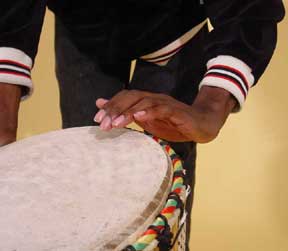To watch a video on "How to Play a D'Jembe" click here.
There are 3 basic sounds made on the D'Jembe; bass, tone, and slap. These 3 sounds are made by hitting the D'Jembe different ways. Below are some pictures that might help you master the techniques.
You can see all of our African Drums here.
When playing you can position the drum many ways but always make sure to have the bottom of the D'Jembe slightly tipped up so that sound can go through the bottom.
 |
 |
 |
|
Bass Make sure your hand is almost flat with the palm slightly below the rest of the hand. Hit the drum directly in the center of the drum, it should produce a hollow bass sound. |
Tone This should produce a higher pitch, cup your hand slightly and hit the edge of the drum, the center joints of your fingers should be on the corner of the skin and the edge of the drum. |
Slap This is the most challenging sound to produce and will take a little practice. You want all your fingers from the edge of your middle finger to the pinky to hit the drum. You want to hit in between the direct center and the edge. You want to pull your hand back and just swipe this area of the drum with your hand, this should produce a slap sound. |
After these three sounds have been mastered it is important to practice. Spending about 30-45 minutes a day will help you to master the art of the Djembe in little over three weeks. After tones, it is good to take up drumming patterns which will give you a set of different sounds at different meters. After learning basic D'Jembe patterns, a little more time listening and experimenting will allow you to accompany music as well as compose and come up with your own. Make sure, especially when starting, to take a break every 10 minutes or so and shake out the tension in your hands, arms, and shoulders.
Most western D'Jembe patterns have a lettering system so that you know which hits you would perform in a phrase.
capital letters stand for the right hand
lower case letters stand for the left hand
B = bass
T = tone
S = slap
. stand for rests
So a pattern like this T.s.B would be translated into 1 right hand tone, rest, 1 left hand slap, rest, 1 right hand bass.
Remember to keep practicing and experimenting!
See our largest selection of musical instruments.
This article is free. You can publish or circulate this article on other websites as long as you give credit to Africa Imports; and include a link back to africaimports.com at the end of the article.
 USD
USD  GBP
GBP  CAD
CAD  AUD
AUD 